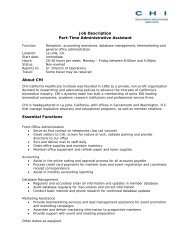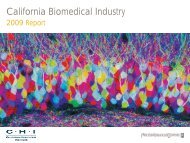California Biomedical Industry - California Healthcare Institute
California Biomedical Industry - California Healthcare Institute
California Biomedical Industry - California Healthcare Institute
Create successful ePaper yourself
Turn your PDF publications into a flip-book with our unique Google optimized e-Paper software.
Figure 4: <strong>California</strong> biomedical vs.other high-tech industries, 2009Computer and Internet-related services<strong>Biomedical</strong>Motion pictures148,298Computers and peripheral manufacturingTelecommunications110,240Aerospace manufacturing70,783146,759Figure 5: Change in employmentamong <strong>California</strong>’s high-techindustriesSector 2008 2009%ChangeAerospacemanufacturing 73,135 70,783 -3.2<strong>Biomedical</strong> 273,559 267,772 -2.1Computer andInternet relatedservices 275,615 259,616 -5.8Computer andperipheral equipment 159,306 146,759 -7.9Motion pictures 163,392 148,298 -9.2Telecommunications 117,539 110,240 -6.2Figure 6: Employment growth in<strong>California</strong>’s biomedical industry bysector<strong>Biomedical</strong> sector 2005 2009259,616267,772AverageannualgrowthrateAcademic research 39,108 42,866 2.3%Biopharmaceuticals 73,472 80,560 2.3%the biomedical industry’s importance incontinuing to provide work and incomefor <strong>California</strong>ns.In comparison to other high-techsectors, life sciences companiescontinue to be a key component of thestate’s workforce. Among the GoldenState’s innovative, high-tech sectors,biomedical is second only to computerand Internet-related services andcomputer and peripheral manufacturing(Figure 4). In 2009, the informationtechnology sectors (including computerand Internet related services andcomputer and peripheral manufacturingindustries) employed an estimated406,000 people, compared to thebiomedical industry’s 268,000.The next largest employer was themotion picture industry with 148,000employees. This ranking has held steadyfor the past 15 years.<strong>Biomedical</strong> employment numbers,however, have been the most resilientamong the high-tech industries (Figure5). At year-end 2009, biomedicalemployment had dropped 2.1 percentas compared to the end of 2008.Aerospace manufacturing lost morethan a percentage point more than didbiomedical and the other sectors sawlosses that were multiples higher.The biomedical industry’s relativestaying power is important not onlyto the sector’s immediate employees.An estimated 655,000 additional<strong>California</strong>ns are employed either partorfull-time because of the life sciencesindustry. From professionals who servedrug and device companies to thosewho provide goods and services to lifesciences employees — combined withbiomedical personnel — an estimated4.6 percent of the state’s total workershold biomedical industry related jobs.Considering its cumulative growth from2005 through 2009, the biomedicalindustry as a whole remains on apositive track. Overall, biomedicalorganizations added nearly 12,000 jobsover that five-year period. Some sectorsfared better than others (Figure 6).From 2005 through 2009, academicresearch and biopharmaceuticals grewat an average annual growth rate ofmore than 2.3 percent. Wholesaletrade grew at an average annual rateof 1.5 percent, but laboratory servicesand “medtech” companies lost enoughground in 2009 to show actual declinesover the five-year period.WagesNot only has the <strong>California</strong> biomedicalindustry sustained most of its jobs, itcontinues to compensate employeeswell. In 2009, life sciences employeesearned a total of $19.4 billion. Theaverage annual wage for the industryacross the state in 2009 was $72,332,down slightly from $74,797 in 2007and 2008.Compensation varies among theindustry’s sectors (Figure 8). Atan average of nearly $100,000 inLaboratory services 5,814 5,493 -1.4%Medical devices,instruments anddiagnostics107,846 107,447 -0.1%Wholesale trade 29,568 31,407 1.5%Figure 7: Direct, indirect and induced economic contributions of the biomedicalindustry to the <strong>California</strong> economy, 2009Employment Labor income ($B) Output ($B) Value added ($B)Direct contribution 268,000 30 114 50Indirect contribution 308,000 22 58 34Source: Bureau of Labor Statistics Quarterly Census ofEmployment and Wages and Company SpecificSEC filings.Induced contribution 347,000 18 52 32Total contribution 923,000 69 224 115Total contribution as a percentof the state economy4.6% 6.0% 6.9% 6.2%Source: Estimates based on the IMPLAN modeling system.Numbers may not add to total due to rounding.10 | <strong>California</strong> <strong>Biomedical</strong> <strong>Industry</strong> 2011 Report






